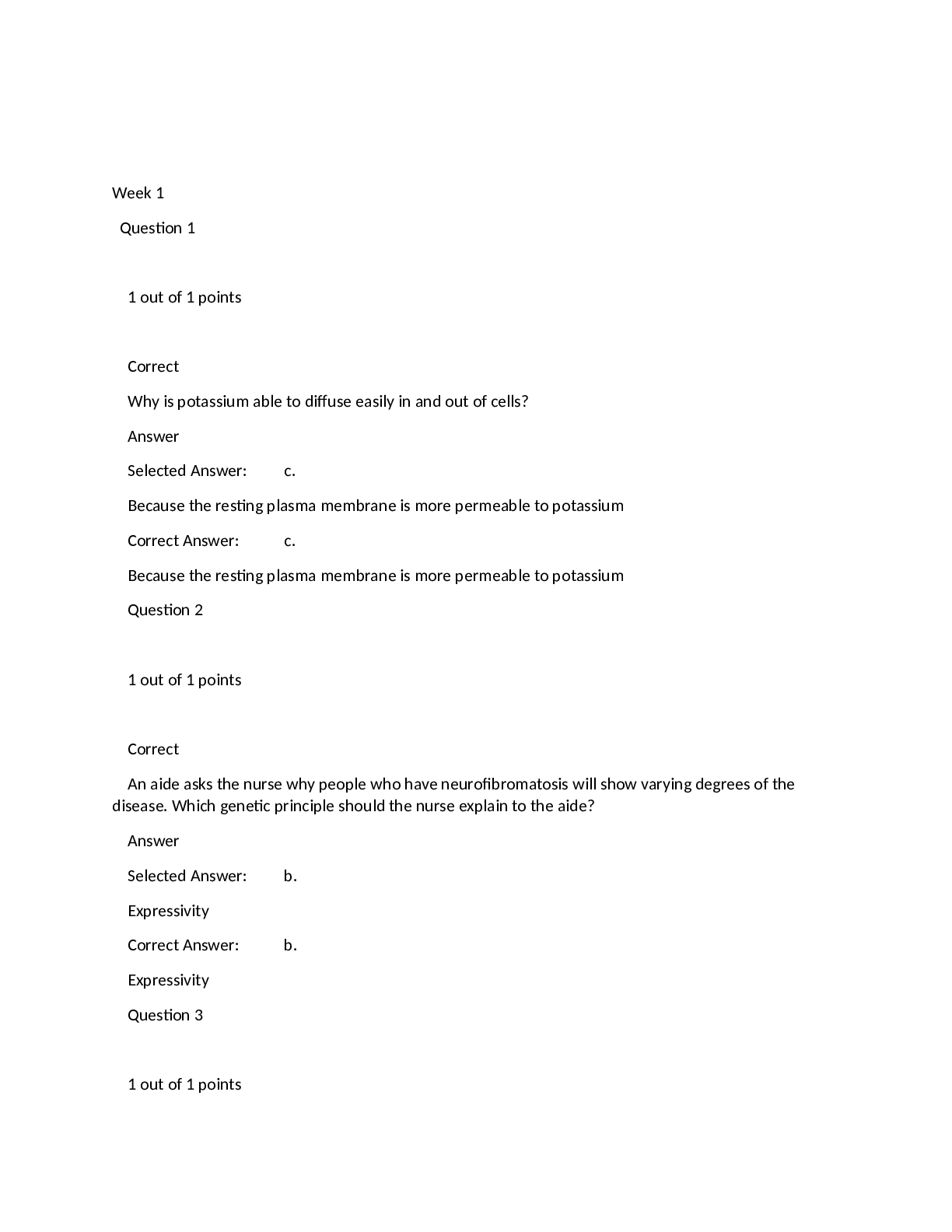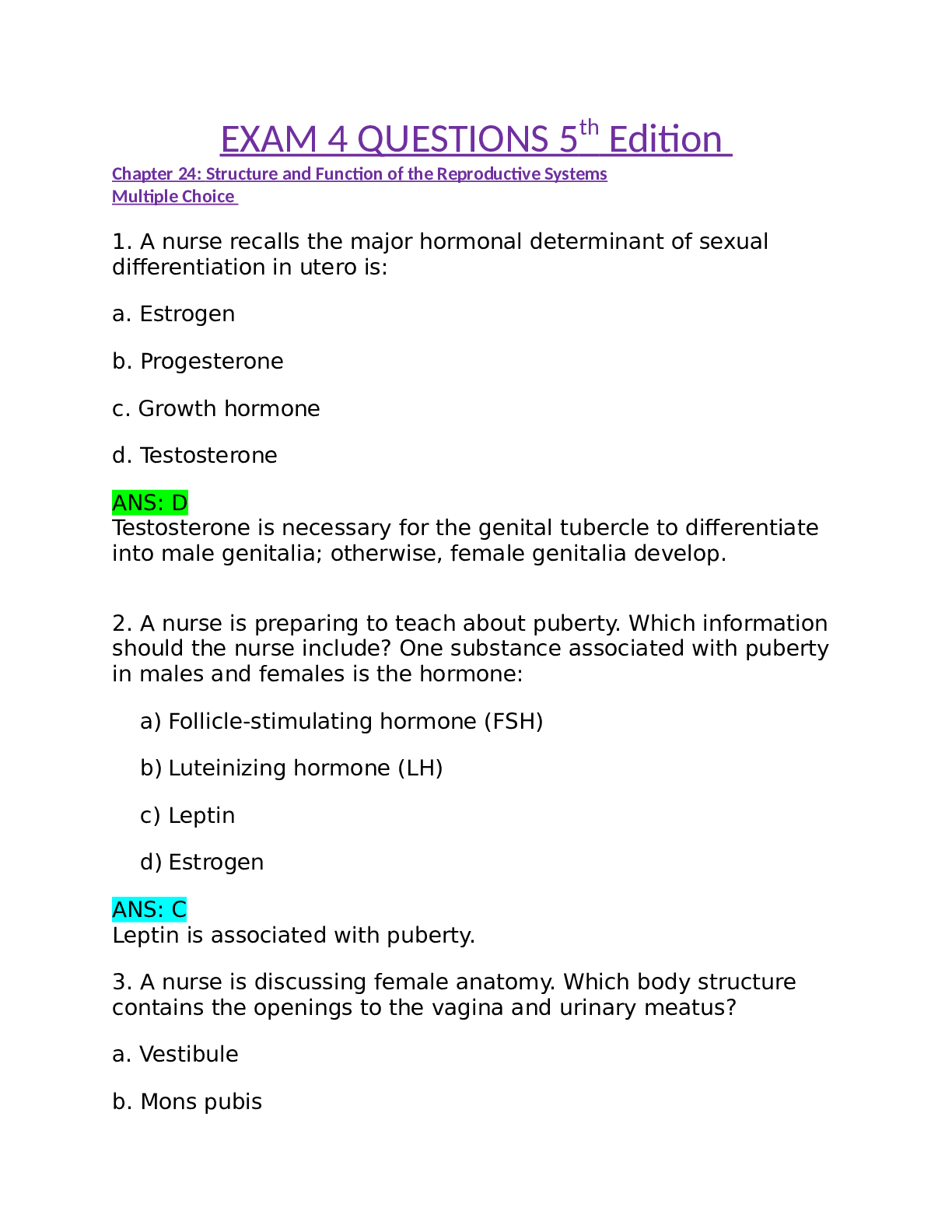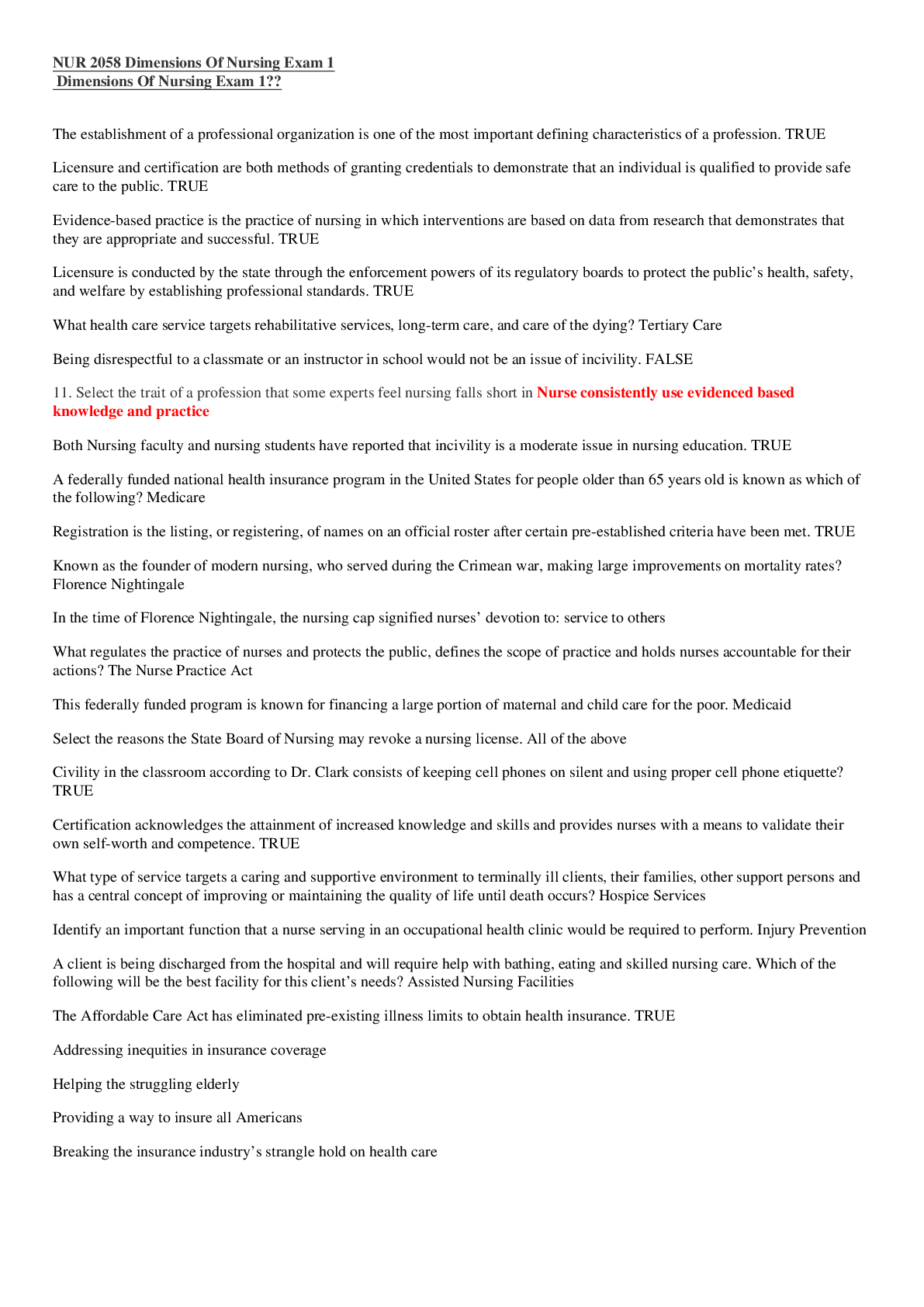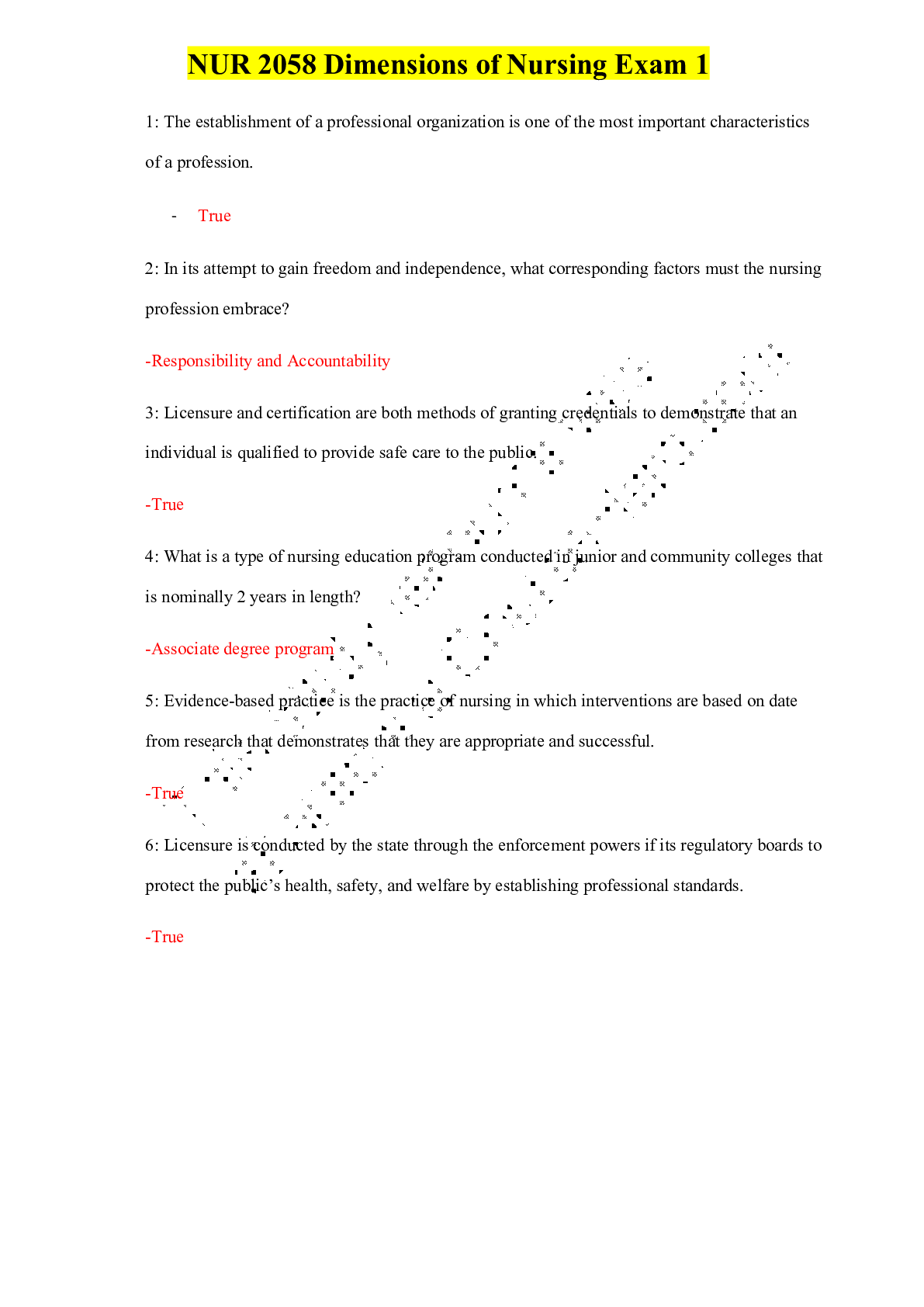NUR 2058 Dimensions Of Nursing Exm 2 Quiz 2 Key Concepts Chapter 1
Document Content and Description Below
What is critical thinking? - In nursing, critical thinking for clinical decision-making is the ability to think in a systematic and logical manner with openness to question and reflect on the reasoni... ng process used to ensure safe nursing practice and quality care What is all included in the nursing process? - http://www.nursingprocess.org/Nursing-Process-Steps.html Think of examples for the nursing process. - Chapter 2 What are some strategies for learning preferences? - Verbal/written, auditory/oral, visual/graphic, kinesthetic/tactile concrete, active/reflective https://www.bowdoin.edu/baldwin-program/student-resources/learning-styles.shtml Think of examples of different learning preferences. - Verbal/written: writing notes on flashcards, speaking the material out loud - Auditory/oral: recording yourself and listening to it - Visual/Graphic: drawing pictures, graphs, and charts - Kinesthetic/tactile concrete: learn through sight, smell, movement, touch, and color - Active/reflective: processing information ‘on the go’ Chapter 3 What does the Benner model consist of? - Her model has also been relevant for ethical development of nurses since perception of ethical issues is also dependent on the nurses' level of expertise. This model has been applied to several disciplines beyond clinical nursing, and understanding the five stages of clinical competence helps nurses support one another and appreciate that expertise in any field is a process learned over time Know each of the levels and examples. Stage 1 Novice: This would be a nursing student in his or her first year of clinical education; behavior in the clinical setting is very limited and inflexible. Novices have a very limited ability to predict what might happen in a particular patient situation. Signs and symptoms, such as change in mental status, can only be recognized after a novice nurse has had experience with patients with similar symptoms. Stage 2 Advanced Beginner: Those are the new grads in their first jobs; nurses have had more experiences that enable them to recognize recurrent, meaningful components of a situation. They have the knowledge and the know-how but not enough in-depth experience. Stage 3 Competent: These nurses lack the speed and flexibility of proficient nurses, but they have some mastery and can rely on advance planning and organizational skills. Competent nurses recognize patterns and nature of clinical situations more quickly and accurately than advanced beginners. Stage 4 Proficient: At this level, nurses are capable to see situations as "wholes" rather than parts. Proficient nurses learn from experience what events typically occur and are able to modify plans in response to different events. Stage 5 Expert: Nurses who are able to recognize demands and resources in situations and attain their goals. These nurses know what needs to be done. They no longer rely solely on rules to guide their actions under certain situations. They have an intuitive grasp of the situation based on their deep knowledge and experience. Focus is on the most relevant problems and not irrelevant ones. Analytical tools are used only when they have no experience with an event, or when events don't occur as expected. Please refer to this pdf if needed: E:\Dimensions\Exam 1.2.& Final\Exam 2\novice-expert-benner-1.pdf Nursing Now! Chapter 3 What is a theory and how is it used in nursing? - a theory refers to a speculative statement involving some element of reality that has not been proved. - The nursing profession tends to use the term theory when attempting to explain apparent relationships between observed behaviors and their effects on a client's health. What are the key concepts common to nursing models? - using a systematic and structured approach, is one of the key elements that raises nursing from a task-oriented job to the level of a profession that uses judgment and knowledge to make informed decisions about client care. With the use of a conceptual model, nurses can provide intelligent and thoughtful answers to the question, “What do nurses do?” What is general systems theory? A widely accepted method for conceptualizing and understanding the world and what is in it derives from a systems viewpoint. Generally understood as an organized unit with a set of components that interact and affect each other, a system acts as a whole because of the interdependence of its parts. What is an Open system? Pg 53 - Open systems are those in which relatively free movement of information, matter, and energy into and out of the system exists. In a completely open system, there would be no restrictions on what moves in and out of the system, thus making its boundaries difficult to identify With the Orem model, self-care model what are the differences between wholly compensated care, partially compensated care & supportive developmental care. Pg. 59 - wholly compensated care: A person who is able to carry out few or no self-care activities, which the nurse must provide for most or all of the client's self-care needs - partially compensated care: nursing care can meet some to most of their self-care needs but still have certain self-care deficits that require nursing intervention. The nurse's role becomes one of identifying these needs and carrying out activities to meet them until the client reaches a state of health and is able to meet the needs personally - supportive developmental care: Clients who are able to meet all of their basic self-care needs require very few or no nursing interventions. the nurse's main functions are to teach the client how to maintain or improve health and to offer guidance in self-care activities and provide emotional support and encouragement. What is The King Model of Goal Attainment and who developed it? Pg. 60 - The King model also notes that nursing must function in all three system levels found in the environment: Personal, interactional, and social. - The primary function of nursing is at the personal systems level, where care of the individual is the main focus. However, nurses can effectively provide care at the interactional systems level, where they deal with small to moderate-sized groups in activities such as group therapy and health-promotion classes. Finally, nurses can provide care at the social systems level through such activities as community health programs. - In addition, the role of nursing at the social systems level can be expanded to include involvement in policy decisions that have an effect on the health-care system as a whole. What are some examples of primary, secondary, and tertiary interventions? Pg. 67 - The main goal of a primary intervention is to prevent possible symptoms that could be caused by environmental stressors. Teaching clients about stress management, giving immunizations, and encouraging aerobic exercise to prevent heart disease are examples of primary interventions. - A secondary intervention is aimed at treating symptoms that have already been produced by stressors. Many of the actions that nurses perform in the hospital or clinic (e.g., giving pain medications or teaching a client with cardiac disease about the benefits of a low- sodium diet) fall into this secondary intervention category. - A tertiary intervention seeks to restore the client's system to an optimal state of balance by adapting to negative environmental stressors. Teaching a client how to care for a colostomy bag at home after discharge from the hospital is an example of a nursing activity at the tertiary level. It occurs after the client has received a secondary intervention and offers support to the client so that he or she can continue to recover or prevent further deterioration in health. What are the middle-range theories and models? Pg. 67 - middle-range theory is a set of relatively concrete concepts or propositions that lie between a minor working hypothesis found in everyday nursing research. Middle-range theories are less comprehensive and more focused than the major nursing theories but are not as specific or concrete as situation-specific practice theories. Middle-range models develop from middle-range theories, although not all middle-range theories have a model. With the Neuman Model what are the different types of Interventions that can be used? - The Neuman model is based on the nursing process and identifies three levels of intervention: primary, secondary, and tertiary. Chapter 6 What is the code of ethics, how was it developed and how does it help nurses? - The code of ethics is generally defined as a written statement or list of the ethical principles that govern a particular profession. These codes offer guidance to the individual practitioner in making decisions, it provides a framework for decision making. They are general statements, so they don’t give specific answers. What is the system of morals? - In one sense, ethics can be considered a system of morals for a particular group. There are usually no systems of enforcement for those who violate ethical principles; however, repeated and obvious violation of ethical precepts of a code of ethics by professionals can result in disciplinary action by the profession's licensing board. Define and think of examples for each: principles include autonomy, justice, fidelity, beneficence, non-maleficence, veracity, standard of best interest, and obligation. -Autonomy: is the right of self-determination, independence, and freedom. It refers to the client's right to make health-care decisions for himself or herself, even if the health-care provider does not agree with those decisions. Ex: An individual refusing care -Justice: is the obligation to be fair to all people. • Distributive justice: states that individuals have the right to be treated equally regardless of race, gender, marital status, medical diagnosis, social standing, economic level or religious belief. Ex: Caring for an individual that is homosexual even though your religious beliefs do not agree with that -Fidelity: is the obligation of an individual to be faithful to commitments made to himself or herself and to others. In health care, fidelity includes the professional's faithfulness or loyalty to agreements and responsibilities accepted as part of the practice of the profession. Ex: “A nurse who is just finishing a very busy and tiring 12-hour shift may experience a conflict of fidelity when she is asked by a supervisor to work an additional shift because the hospital is short-staffed. The nurse has to weigh her fidelity to herself against fidelity to the employing institution and against fidelity to the profession and clients to do the best job possible” -Beneficence: views the primary goal of health care as doing good for clients under their care. Good care requires that the health-care provider take a holistic approach to the client, including the client's beliefs, feelings, and wishes, as well as those of the client's family and significant others. -Nonmaleficence: is the requirement that health-care providers do no harm to their clients, either intentionally or unintentionally. The principle of nonmaleficence also requires that health-care providers protect from harm those who cannot protect themselves. -Veracity: truthfulness. It requires the health-care provider to tell the truth and not to intentionally deceive or mislead clients. It is not a law, just beneficial to patient relationship -Standard of best interest: describes a type of decision made about a client's health care when the client is unable to make the informed decision themselves. The standard of best interest is used on the basis of what health-care providers and the family decides is best for that individual. -Obligation: are demands made on an individual, a profession, a society, or a government to fulfill and honor the rights of others. • Legal: those that have become formal statements of law and are enforceable under the law • Moral: those based on moral or ethical principles that are not enforceable under the law. What are the steps for the ethical decision-making process? - The steps for the ethical decision-making process 1. Collect, Analyze and Interpret the Data: obtain as much information as possible. And analyze all the important things involved in this dilemma. After collecting data, bring the information together that can give the clearest and sharpest focus of the dilemma. 2. State the Dilemma: After collecting/analyzing, the nurse needs to state the dilemma as clear as possible. It is important to identify whether the problem is one that directly involves the nurse or one that can be resolved only by the client, client’s family, the physician, or the DPOAHC. Most of the time, the dilemma can be reduced to a few statements that encompass the key ethical issues. 3. Consider the choices of action: After stating the dilemma as clearly as possible, next step is to attempt to list, without consideration of their consequences, all possible actions that can resolve the issue will be take. This may include input from outside sources 4. Analyze the advantages and disadvantages of each course of action: The identification of these actions becomes readily evident during this step. The advantages and disadvantages are considered in detail. When considering the advantages and disadvantages the nurse should be able to narrow the realistic choices. 5. Make the decision and act on it: The most difficult part of the process. Decisions are often made with no follow-through because fear of consequences. Not everyone will be pleased with the final decision. Chapter 7 How is confidentiality used in genetic and mandatory screening? -In newer genetic and mandatory screening individuals can buy an at home kit and swab their mouth and send it in. Confidentiality is very important because the advantage insurance companies may obtain the results or screen earlier for costly and potential lethal diseases. These individuals could be excluded from health and life insurance coverage, saving the insurance company lots of money. What happens when the donor is a child? What is the difference between passive and active euthanasia? -Passive euthanasia usually refers to practice od allowing an individual to die without any extraordinary intervention (DNR orders, living wills and withdrawal of ventilators and life support -Active euthanasia usually describes the practice of hastening and individual’s death through some act or procedure. Referred to as “mercy killing”. What is the issue of self-determination with euthanasia? -Self determination is Autonomy. Nurses have a strict ethical obligation to refuse to participate in mandatory, involuntary screening programs and are strictly prohibited from revealing genetic test results to unauthorized individuals. Forcing testing on clients who are strongly opposed to finding out information about their genetic status is clearly a breach of those clients’ right to self-determination. What is the nurses legally protected for reporting child abuse? - An incident of a newborn admitted to the nursery with signs of drug withdrawal and positive for cocaine. The mother denied use before delivery. Hospital reported the situation and filed a report with child protective services. CPS removed the child from the home and the mother had to to to court. The mom decided to file a lawsuit against the hospital and personnel. She cited that these entities were conspiring to keep her from exercising her constitutional rights. Because of this trend, the mother's lawyer felt that the case had merit and might result in a ruling in her favor with a large punitive settlement. Looking at all the evidence, the higher court decided that there had been no attempt on the part of the hospital and staff to deprive the mother of her constitutional rights—the mother had been given the opportunity to plead in a lower court shortly after the child's removal from the home. The court upheld the nurses’ requirement to report suspected child abuse and their immunity from civil lawsuits for carrying out their obligations in good faith. Chapter 8 What is civil and tort law? -Civil law generally deal with the violation of one individual’s rights by another individual. The court provides the forum that enables these individuals to have their disputes resolved by an independent third party, such as a judge or a jury of the defendant’s peers. -Tort law is generally defined as a wrongful act committed against a person or his or her property independently of a contract. What is malpractice? Think of examples -Malpractice is a type of negligence for which professionals can be sued. What are the definitions of these intentional torts: assault, battery, false imprisonment, abandonment, and intentional infliction of emotional distress? -Assault: the unjustifiable attempt to touch another person or the threat of doing so -Battery: actual harmful or unwarranted contact with another person without his/her consent -False imprisonment: occurs when a competent client is confined or restrained with intent to prevent him or her from leaving the hospital -Abandonment: occurs when there is a unilateral severance of the professional relationship with the client without adequate notice and while the requirement for care still exists -Intentional infliction of emotional distress: the conduct exceeds what is usually accepted by society, the health-care provider’s conduct is intended to cause mental distress and the conduct actually does produce mental distress. What is the nurse’s duty with informed consents? -Informed consent is the voluntary permission by a client or by the client's designated proxy to carry out a procedure on the client. Nurses can reinforce the information given by the physician and even supplement the material but should not be the primary or only source of information for the informed consent What are advance directives? -The advance directives are meant to encourage people to discuss and document their wishes concerning the type of treatment and care that they want in advance so that it will ease the burden on their families and providers when it comes time to make such a decision. - Living will: s a document stating what health care a client will accept or refuse after the client is no longer competent or able to make that decision. - Medical durable power of attorney: designates another person to make health- care decisions for a person if the client becomes incompetent or unable to make such decisions What does a durable power of attorney do? -The medical durable power of attorney, or health-care proxy, designates another person to make health-care decisions for a person if the client becomes incompetent or unable to make such decisions. How does the Good Samaritan Act protect nurses? - The Good Samaritan Act states that a health-care professional who provides care in an emergency situation cannot be sued for injuries that may be sustained by the client if that care was given according to established guidelines and was within the scope of the professional's education. Chapter 9 Some information on the nursing process can be found here; the majority will be found in the Critical thinking, clinical reasoning, and clinical judgment book. The Nursing Process has traditionally been a very important part of the NCLEX. It consists of five steps: Assessment, Analysis, Planning, Intervention and Implementation, and Evaluation. Implementation has the highest percentage of questions. - Assessment: primarily establishes the database on which the rest of the nursing process is built. Often the examination will ask you to distinguish between appropriate and inappropriate assessment factors. - Analysis: involves developing and using a nursing diagnosis for the care of the client. Questions concerning nursing diagnosis will often ask you to prioritize the diagnoses. The NCLEX uses the North American Nursing Diagnosis Association (NANDA) nursing diagnosis system. The basic rules for prioritization are to use Maslow's hierarchy of needs and the ABCs you learned in CPR (airway, breathing, and circulation) - Planning: primarily involves setting goals for the client. Included in the planning phase are such factors as determining expected outcomes, setting priorities for goals, and anticipating client needs based on the assessment. - Intervention and Implementation: involves identifying nursing actions that are required to meet the goals stated in the planning phase. - Evaluation: determines whether the goals stated in the planning phase have been met through the interventions. The evaluation phase also ties the nursing process together and makes it cyclic. [Show More]
Last updated: 2 years ago
Preview 1 out of 8 pages
 (1).png)
Buy this document to get the full access instantly
Instant Download Access after purchase
Buy NowInstant download
We Accept:

Reviews( 0 )
$10.00
Can't find what you want? Try our AI powered Search
Document information
Connected school, study & course
About the document
Uploaded On
May 25, 2021
Number of pages
8
Written in
Additional information
This document has been written for:
Uploaded
May 25, 2021
Downloads
0
Views
39








 (1).png)












.png)


